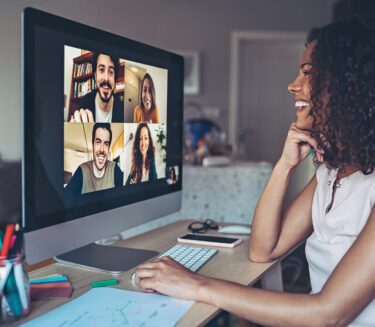You install a new app on your phone.
Your friends have it, celebrities use it, and it’s going viral on social media. It finishes installing, and a window pops up — Terms and Conditions.
You scroll to the bottom, click ‘accept’, and continue the account creation process.
In that act, you’ve put your trust in three different parties. Your peer group for vetting it. Pop culture for celebrating it. The app developer because… you weren’t going to read all that text.
When it comes to our data — an increasingly crucial part of our identity and privacy — we are quick to offer our unexamined trust with the simple click of a checkbox.
It’s just so easy.
But as with everything in life, nothing comes for free. So, what’s the catch?
Amy Webb, Futurist and best-selling author and Debbie Gamble, Chief Officer, Innovation Labs & New Ventures at Interac, sat down to discuss the security implications Canadians should keep in mind when surrendering our trust.
If we keep treating our data with the passiveness that we do today, what does our future look like? And most importantly, how can we change it and protect our data?
What does trust really mean?
It’s important to understand what, exactly, we mean by ‘trust’. According to Debbie, it means transparency, clarity, and ease. It means the average consumer should be able to effortlessly and reliably “control when, how, and what they share. It means being relevant and…inclusive.”
It sounds simple; a no-brainer. Of course, users should be in control…aren’t we already?
For Debbie, “trust needs to be a conscious expectation. And that conscious expectation needs to be made concrete.”
The crossroads of trust
The COVID-19 pandemic has increased the pace of disruption, whether education, business, or the very nature of democracy itself. However, due diligence cannot be pushed aside to support our rapidly shifting world, warns Debbie.
“If data is the new oil, a commodity good, then trust is indeed a currency,” says Debbie.
This is where leaders can continue to build value for their customers, employees and partners. For companies, establishing and maintaining trust at every interaction should become a business imperative.
“Done well, not only can it be an expression of our brand, but it can also become our competitive advantage.”
The Stakes
You may ask yourself, ‘so what if companies use my data’?
As a Futurist, Amy’s expertise lies in assessing global trends and using them to draw likely conclusions about the future, which people in her world call “scenarios.” She’s narrowed the uncertainties to three likely narratives based on the decisions around data and data security we’re making today, explained in detail in her book The Big Nine: How the Tech Titans and Their Thinking Machines Could Warp Humanity.
Scenario 1: Our rights are protected
Amy’s best-case scenario lands us in a future where we’re all-in on trust, regulation and accountability. In this world, users actively benefit from data that’s heavily regulated by a “global alliance” that sets norms and standards, performs risk modeling, and upholds data hygiene to protect the data and rights of users.
Scenario 2: We stay the course
We continue forward, business as usual. We remain tethered to what Amy calls the G-MAFIA (Google, Microsoft, Amazon, Facebook, IBM and Amazon). Decisions are made for us based on the technology we use, and the lack of interoperability between tech companies creates rifts between families and users based on alliances rooted in economic status and the technology platforms they are tied to.
Scenario 3: Humanity is ‘fatally imperiled’
This is the worst-case scenario, in which “the US continues its isolationist stance”, allowing China to continue ahead in its development. The new world order is established in what Amy refers to as the One China Policy, where countries are using China’s technology, or they are not. Trade and travel are disrupted, and “things get worse and worse until the end when humanity is fatally imperilled.”
Needless to say, the stakes are high.
So how do we avoid the worst-case scenario?
Amy Webb shares 6 things we can do today
#1 Use second order thinking
The first and most important thing is to think carefully and analytically about the devices we use. This applies both as a user and as a business leader. Instead of ending the thought process at “that data will give me access to a basic service,” continue to the second-order question of “…but what happens with that data if I make this decision? How does that implicate me and my employees?”
Amy offers the example of the upcoming saliva COVID-19 detection test, which has garnered excitement from many people, including CEOs planning to welcome employees back to an office with daily testing. A surficial benefit to be sure, but at what cost?
“Who owns this data?” asks Amy. “None of that makes sense. To me, this says, that the person running this organization doesn’t have a good enough understanding of biometric data, data surveillance, everyday data or metadata from the industrial internet.”
She doesn’t expect every person to know the details of regression algorithms or computer visioning. But “everyday people must be more aware of how the devices that we have a more intimate relationship work.”
We can start by asking:
- What data is being collected or scraped?
- Who will own it?
- How is it being authenticated?
#2 Later is now – it’s time to deal with data hygiene
If you’re a leader at a company, it’s time to prioritize data. It’s no-one’s favourite task, and Amy is the first to admit that data is anything but sexy, but we simply can’t afford to wait any longer.
“At some point with all of this ‘dealing with that later’, we’re going to have a reckoning,” says Amy. “Indeed, the reckoning may actually be already upon us,” agrees Debbie.
“You really need to think hard about trust, data hygiene, and risk, and making sure that the data you’re collecting is being put to good use,” says Amy. “There are big questions that we’re going to have to ask moving forward, even today.”
#3 Monitor trends thoughtfully
Like Futurists, businesses can monitor trends to help them anticipate what’s coming down the pipeline. Business leaders need to look for patterns and inflection points in places where disruption tends to start. That means looking outside their own organizations and industries and into areas such as geopolitics, wealth distribution and the environment.
#4 Seek daily disruption
Amy recommends that in order to prepare our brains for disruption, it is a good idea to seek out small disruptions every day.
“We’re all living in groundhog day,” says Amy. “Every single day, do one thing different. Get out of the other side of the bed. Walk around the block in a different direction.”
Amy suggests that if we do one thing different every day and take a moment to observe the changes, we can help create new neural pathways to help our brain take in and process novel data points.
“If we don’t intentionally look for disruption on our own, it just happens at us and we feel we don’t have control. Seek out change and disruption.”
#5 Steer into the slide
Right now, companies and individuals alike are in a panic response. The world has turned upside down, industries are experiencing major shifts, and unpredictability is impairing foresight and planning.
In times like these, our natural inclination is to slow down and get control, but according to Amy, that’s not what we need to be doing.
“In times of growing uncertainties, people and companies’ limbic systems kick in,” explains Amy.
The limbic system helps the body respond to intense emotions of fear and anger by activating the fight, flight, or freeze response. This is the response that’s at play in a crisis situation, like hitting a patch of ice while driving.
Of course, as any winter-driver knows, that’s not the response we’re supposed to have. Instead, we’re supposed to stay calm and manage the car using the momentum it has at that moment, not the momentum we want it to have.
“Steer into the slide – the very thing that’s causing all of our anxiety,” says Amy. “Lean into it while we keep our eye further down the road for where we’re trying to actually go.”
The best thing companies can do right now, according to Amy, is to keep their eye on the far future, constantly recalibrate, and make incremental decisions.
#6 Be a realist
When we talk about the future of data and data security and privacy, the trust that’s so essential for our survival, it can be tempting to feel defeated.
But Amy is quick to remind us that the future is not pre-determined. It is something we build every day.
“Tell your limbic system, ‘Freak out all you want. I’m going to lean into that anxiety while I continue to work for the future I want to build. Because I think it can be better.’”
Both she and Debbie agree that as long as users and leaders alike choose to look forward, ask the right questions, and build value and trust into every interaction, we are going to be fine.
Let’s start building.
Interac makes data security its top priority



